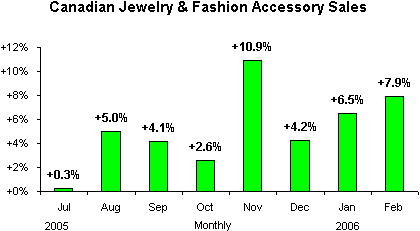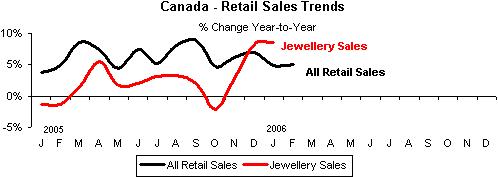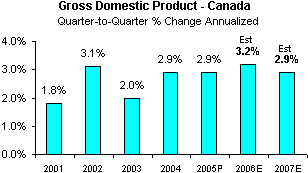IDEX Online Research: Canadian Jewelry Sales Show Solid Gains
April 23, 06
Jewelry sales in Canada have shown solid accelerating gains for the past several months. February jewelry sales were particularly strong, driven by consumer demand for jewelry and other fashion accessories.
The graph below shows sales trends of fashion accessories, including jewelry, for Canada through February 2006, as reported by StatCanada.

Source: StatCanada
February jewelry sales were stimulated by the Valentine’s Day selling period. In January, it is important to note that retail sales were stimulated by two factors:
- $400 rebate in Alberta – Everyone in Alberta received a $400 rebate from the government in January. This accounted for a spike in retail sales early in the year in that province.
- Gift cards – Canadians are giving more gift cards at Christmas. These cards do not count as retail sales until they are redeemed, usually in January and February.
By province, Ontario, Newfoundland, and Labrador showed the weakest sales in February. All other provinces and territories registered solidly positive sales growth.
The following graph isolates jewelry sales (excluding all other categories included in “fashion accessories” such as shoes) as compared to total Canadian retail sales (excluding automobiles). It is clear that jewelry demand remains robust in Canada.

Source: StatCanada & ICSC
Outlook: Solid Gains Projected
The outlook for jewelry demand in Canada remains positive.
- Strong economy – Canada’s economic growth is expected to continue unimpeded for the balance of the year. In part, this is due to its neighbor to the south – the United States, the country’s largest trading partner – which is expected to post solid economic growth. Jewelry demand and economic growth show a very high correlation; thus, as long as economic growth shows no signs of wavering, Canadian shoppers are expected to continue to buy jewelry at a steady pace.

Source: Consensus Estimates
- Broad-based economic gains – Along with strong economic growth, it is important to note that all sectors of the Canadian economy – business spending, consumer spending, government spending, and export revenues – are also showing consistently solid gains.
- Strong job growth – Unemployment levels remain low and job growth is strong. In addition, wage growth has been solid. As long as consumers feel confident about their job prospects, they will continue to spend.
- High commodity prices – Commodity prices are soaring, and Canada, which is a major producer in the global commodities markets, is benefiting. While some commodity prices are up sharply due to investment speculation, underlying demand for those commodities is being driven by developing nations such as China and India. As long as those developing nations continue to grow, commodity demand should remain strong.
- Consumer inflation moderate – Despite rising gasoline prices, inflation at the consumer level is moderate. Thus, consumers are not being robbed of their spending power by sharply rising prices.
- Government status-quo – Despite elections earlier this year which changed the guard in Canada’s Parliament, it is unlikely that any sweeping changes will be made which might affect consumer spending (in fact, it is unlikely that changes affecting anything will be made due to the lack of a strong majority party. The major parties want the GST cut, but it is unclear how those revenues would be replaced.
There are only a few negative factors which could affect consumer spending in Canada.
- Higher interest rates – It is clear that the Bank of Canada will continue tightening; this will drive interest rates higher. As a result, Canadian consumers may cut back on demand for goods which are typically financed over many months on the easy-payment plan.
- Weaker U.S. dollar – The U.S. dollar is expected to continue to weaken in 2006. As a result, demand from Americans for Canadian-produced products may slow modestly.
- Slowdown of housing market – The Canadian housing market is slowing, in part due to higher interest rates. This will slow the rate of price inflation for homes, and will cause consumers to be more cautious.